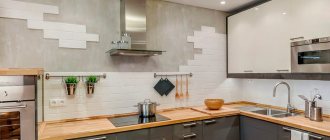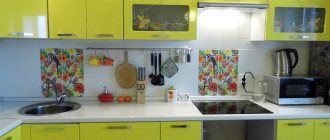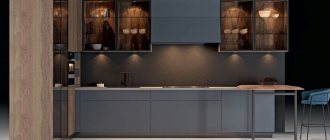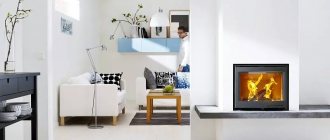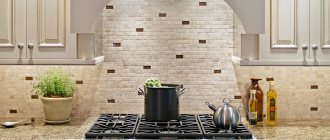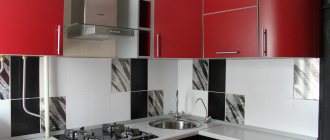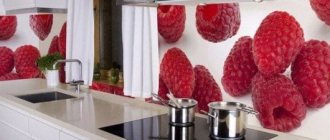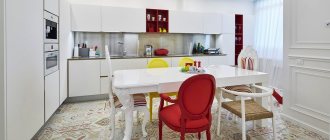White is a universal color for interiors. Since it is considered achromatic, it can be combined with any shade and integrated into any style. Finishing the wall above the work surface with white material is undoubtedly a beautiful solution. And you don’t have to worry about practicality either - the main thing is to choose the right material. Tiles of different shapes and textures and artificial stone would look appropriate. Our article contains beautiful examples of white aprons in different kitchens: both colored and white.
Pros and cons of a white apron in the kitchen
The Total White trend is becoming more and more popular every year. A white kitchen apron looks stylish, fresh and modern, perfectly coping with its functions - protecting the finish from dirt and moisture. It can be placed only above the work area, extend to the sink and even take up the space above the stove.
Total White has been a popular trend lately.
It will fit well in both a white kitchen and a kitchen with a contrasting base color.
A white apron has a number of advantages:
- this is a universal element for almost any style: hi-tech, Provence, Scandinavia, classic, etc.;
- white visually expands the space, so it fits perfectly into a small kitchen;
- a white apron is an element of monochrome that will not go out of style for a long time;
- the white element in the kitchen matches almost perfectly with any colors, so if you change the style during the renovation process, it will easily fit into the updated interior;
- The lighting and any kitchen utensils that can be placed on the rail will look great on a white background.
A white backsplash looks great in brightly colored kitchens.
Of course, we cannot fail to mention the disadvantages of white in the kitchen. Basically this is the need for more careful care. The material for the apron should be selected in accordance with the basic concept of the kitchen.
What material can be used to make a white apron in the kitchen?
The variety of materials for creating a kitchen apron is enormous, despite the strict requirements for them: it protects the walls from dampness, steam, temperature changes, splashes of hot fat, and simply dirt. Therefore, the material for the apron should be cleaned well and quickly, not accumulate dirt in the pores, and not contribute to the growth of bacteria.
The apron protects the wall from dampness, temperature changes, splashes of hot fat, and simply dirt.
And under such harsh conditions, it can be made from a huge number of materials. Let's look at what materials kitchen aprons are made of, what their pros and cons are, and also what style each proposed option is suitable for.
Ceramic white tiles
Ceramic tiles are a traditional element in the kitchen: they are durable, easy to clean, and do not deteriorate from exposure to fat and moisture.
There are several different methods of laying tiles:
- Brickwork is a traditional option for decorating a backsplash: rectangular tiles create the illusion of a wall painted white. This design looks discreet and fits well into rustic and modern styles: loft, art deco, Scandinavia, etc.
- Combined masonry assumes that some of the tiles are laid out in the traditional way, and the other part - diagonally or vertically. You can lay out a small panel in this way or highlight some part of the apron - upper or lower.
- An even laying of square tiles will look discreet and organic above the sink, work area, or hob. This is an ideal option for industrial, minimalism, retro, etc. styles. Small square tiles will look good in rustic styles, as well as pin-up, etc.
- Herringbone laying is only possible with rectangular tiles. This installation looks good if parquet is laid on the floor. It will add completeness to such interior styles as Provence and vintage, retro and modern.
- Zigzag laying is a transverse version of the herringbone, this is an excellent option for a kitchen in the eclectic, fusion, or pop art style. Also, this design will add zest to rustic styles.
The apron is made of white ceramic tiles with brickwork
Textured tiles
Textured or relief tiles imitate stucco patterns, stone or brick textures, geometric or floral patterns. Luxurious stucco molding on the apron will look great in kitchens decorated in classic, empire, baroque, Greek, etc. styles.
An apron made of relief tiles in a cozy kitchen.
Brick and stone symbolize naturalness and simplicity in cozy, rustic styles. They will look brutal and fashionably rough in loft, techno, and modern kitchens.
Floral patterns will fit well into eco-styles, Biedermeier style, etc. Geometry is more typical for the minimalist Japanese style, Art Nouveau, Scandinavia.
White brick-shaped apron in a loft-style kitchen.
Glass apron
Skinali or glass aprons have been firmly in the fashion trend for the last few years. They look beautiful, are effective due to their reflective properties and are easy to care for. White skins can be glossy and matte, textured and smooth, rich and translucent.
A glossy glass splashback is an excellent solution for the kitchen.
Skinals will harmoniously fit into the styles of high-tech, minimalism, Scandinavia, futurism - that is, into those styles in which smooth lines and reflective surfaces come first. This finish will go well with inexpensive plastic kitchen furniture.
The white was thrown off in the kitchen in a minimalist style.
Mosaic splashback
The mosaic design of the apron, even in monochrome, will look elegant and original. The mosaic will look impressive made from a variety of materials:
- white glass;
- ceramics;
- smalts.
Mosaic design of a white apron.
The elegant design created by mosaics will look good in eclectic, modern and retro styles. White mosaic patterns of different shades can be used in ethnic and rustic styles.
Wooden apron
If you want originality, a wooden apron painted white will look great in some styles. MDF panels are moisture resistant and easy to maintain and install. They are not recommended to be installed near gas stoves: the material is highly flammable. Laminate can be a good alternative to MDF. You can even use natural wood, but the area around the stove will have to be lined with a different material.
A wooden apron is an excellent option for an original work area.
Wall decoration made of white wood is a spectacular option for modernism, eco-style and Japanese minimalism. This apron will not be snow-white, since in any case, veins of a brownish tint will be visible in the wood grain, which must be taken into account when choosing a color scheme for the kitchen.
Stone apron
An apron made of white stone will add respectability to the interior.
To create an apron you can use the following materials:
- White marble will look chic. This is a luxurious, expensive solution for such difficult styles as classic, baroque, empire, rustic, modern, etc.
- Lithoceramics or composite tiles are a cheap analogue of marble coating. The material is a combination of a ceramic base and a layer of natural marble.
- You can use other types of stone to decorate your kitchen: limestone, granite, etc.
Stone apron in a white and black kitchen.
A stone wall will look natural in eco-interiors, as well as in rustic, loft, English, Greek, etc. styles.
Plastic apron
Plastic is an inexpensive and very practical material for finishing walls in the work area. PVC panels are inexpensive, easy to clean, and look just as fashionable as ceramic or glass aprons. This is a good option for modern kitchens. The PVC apron goes well with any furniture - plastic and wooden.
Plastic is an inexpensive and practical material for finishing a kitchen apron.
Comparisons with other types of finishes
Instead of tiles, various materials can be used to decorate the apron. The following requirements apply to their characteristics:
- resistance to high temperatures;
- moisture resistance;
- ease of cleaning;
- hygiene;
- beautiful appearance.
The choice can be made in favor of white laminate. It will be possible to form an original surface. But the choice of material should be approached with special responsibility. Most coatings quickly lose their presentability. They are not designed for use in such conditions. You will have to come up with certain methods of protection to make the care process easier.
Metal sheets can also be used to line the work area. However, when choosing this option, you should remember that the smallest droplets will be immediately noticeable. In addition, when using abrasive particles to clean the surface, characteristic defects may appear on the surface of the apron.
Backlight
A white apron with lighting looks especially impressive. The most common lighting option is to install lamps with directional light directly above the apron. Such lighting will allow you to illuminate the work area in a directional manner and will not shine into the eyes of those sitting at the table.
White apron with lighting in a white kitchen.
If there are wall cabinets above the apron, then lamps placed on the bottom of the cabinets will be more convenient. It is better to choose LED strip or fluorescent lamps for these purposes - they provide more uniform illumination. Spotlights are too bright and will reflect unattractively on a glossy surface as blinding spots.
Lamps located at the bottom of the cabinets are a convenient placement option.
For glass skinals, the backlight can be of 2 types:
- The LED strip is attached to the top and bottom of the panels. For this, a special aluminum profile with channels for LED strip and wiring is used. The thin and narrow profile does not catch the eye.
- The backlight can be attached to the back of the glass panel, which is moved away from the wall using remote holders. The LED strip is recessed into a niche. This lighting looks very modern - in the form of a clear luminous strip.
A white apron looks most impressive with lighting.
In a modern minimalist kitchen with a white monochrome apron, colored LED lighting with RGB tape - purple, blue, green, red - will look good. Using the remote control, you can control the installation of a dynamic mode with changing colors or other effects, or fixing a specific one color.
Purple LED lighting in the kitchen with a white backsplash.
What styles would a white apron look good in?
The design of the apron should be in harmony with the style of the kitchen.
A white apron can fit well into absolutely any style, except, probably, Gothic:
- In a classic kitchen, a white tiled apron will always be in place.
- Baroque presupposes textured patterned white tiles, but skinned ones will look more impressive in such an interior: white frosted glass with a frosted pattern is perfect for a luxurious palace design.
- Modern – glossy white acrylic panels would be appropriate in such an interior. It is better not to use textured materials here.
- Rustic styles will primarily prefer white glossy brick, that is, its ceramic imitation.
- Minimalism and techno will prefer white frosted glass.
- Fashionable Scandinavian trends for aprons offer clearly white brick.
White tile backsplash in a classic kitchen.
How to lay it down?
When choosing a finishing material, you should not only decide on its characteristics, but also the procedure for performing installation work. The same tile will look different depending on the installation method chosen. When choosing, the size and shape of each element are taken into account. Installation can be done:
- in the classic way, which involves installation “seam to seam”. As a result of installation, even rows are formed with elements arranged in a given sequence;
- diagonally, involving the formation of diagonal lines using seams. The option is more technically complex. It is quite difficult to do the installation work yourself. Certain knowledge and skills are required. In some cases, to obtain a greater effect, diagonal inserts are alternated with the classic installation method;
- with an offset suggesting some vertical displacement of the elements. The displacement step is chosen arbitrarily. At the same time, the distance must remain constant in all rows so that the illusion of low qualification of the master does not arise;
- herringbone For clarity, you can recall the laying of parquet. This method of installation is especially popular among craftsmen. One zigzag lines of white color look original on the wall surface. To enhance the effect, the seams are made contrasting. To implement the project, narrow rectangular tiles are selected;
- chess. The classic version assumes a combination of white and black. When installing a white apron, you can choose elements of different shades. In this case, you cannot count on strong contrast, but smooth transitions will add originality to the surface;
- Along the lines. The method is close in essence to the classical version, but for its implementation elements of an oblong rectangular shape are used.
What colors go with a white apron in the kitchen?
An all-white kitchen with a white apron and small color accents will look stunning. It combines harmoniously with furniture of any color, texture, color and shape. Any accessory will look amazing against a snow-white wall - a chrome microwave, a vase of flowers, kitchen utensils.
White backsplash in a white kitchen with a dark countertop and a black oven.
White color is neutral, it acts as an excellent separator for many shades, so a white screen will be equally appropriate in monochrome gray techno and colorful modern or contemporary. Gray is considered a shade of white: this combination is preferable for modern style interiors: techno, industrial, fusion will perfectly accept a white wall into their predominant gray.
One of the best combinations is a gray kitchen and a white apron.
Contrasting - classic black and red, black and white, red and gray kitchen colors also allow you to make a white apron. It will look especially good as a separator between the colors of the lower and upper tier of cabinets in the kitchen. Here the apron can play the role of a color accent in the interior. Contrast is typical for bright styles - modern, minimalism, hi-tech.
A white apron would be appropriate in a contrasting black and white kitchen.
Colored kitchen decoration includes several shades, sometimes even up to five. White finishing of the work area can either act in such interiors as a link for other shades or as a color accent in modern, but more ornate styles - retro or vintage.
A white apron can be a successful combination of several colors in the kitchen
Tabletop
The countertop plays almost the main role of the kitchen. The most popular surfaces are pure white or neutral shades. These can be gray, beige, soft brown colors.
An excellent option would be stone worktops. They are distinguished by a natural color scheme, and the veins will help disguise small dirt.
Black shades will look very impressive, but caring for them will become a real little nightmare for super-clean housewives.
